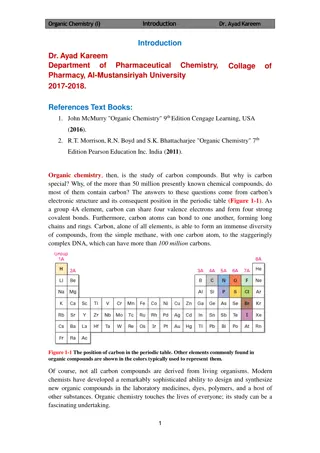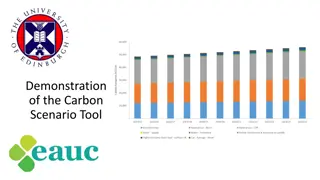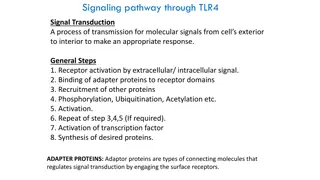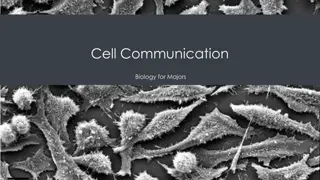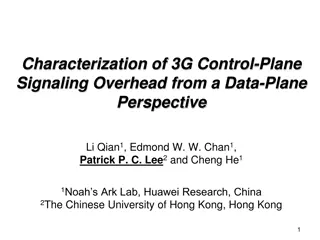Understanding Eicosanoids: 20-Carbon Signaling Compounds in Physiology
These 20-carbon compounds, including prostaglandins, thromboxanes, and leukotrienes, are crucial chemical signals between cells, controlling various physiological processes and inflammation. Arachidonic acid serves as the main eicosanoid precursor, metabolized through pathways involving enzymes like COX and lipoxygenases. The balance of COX-1 and COX-2 expression impacts cellular functions and responses, with implications for drug therapies targeting these pathways.
Download Presentation

Please find below an Image/Link to download the presentation.
The content on the website is provided AS IS for your information and personal use only. It may not be sold, licensed, or shared on other websites without obtaining consent from the author. Download presentation by click this link. If you encounter any issues during the download, it is possible that the publisher has removed the file from their server.
E N D
Presentation Transcript
These are 20-carbon compounds that include: prostaglandins, thromboxanes, prostaglandins, thromboxanes, leukotrienes compounds compounds. leukotrienes, & related , & related They are generated from phospholipid precursors. They function primarily as hormone-like chemical signals between cells. They are implicated in the control of many physiological processes, and are among the most important mediators and modulators of the inflammatory reaction. They are a very significant target for drug action.
Structure and biosynthesis In mammals, the main eicosanoid precursor is arachidonic acid acid (5,8,11,14-eicosatetraenoic acid), a 20-carbon unsaturated fatty acid containing four double bonds. arachidonic The initial and rate-limiting step in eicosanoid synthesis is the liberation of arachidonate from cell membrane phospholipids by the enzyme phospholipase A Several species exist, but the most important is probably the highly regulated cytosolic PLA cytosolic PLA2 2. Cytosolic PLA2is activated (and hence arachidonic acid liberated) by phosphorylation. This occurs in response to signal transduction events triggered by many stimuli, such as thrombin action on platelets, bradykinin action on fibroblasts, antigen-antibody reactions on mast cells. General cell damage also triggers the activation process. phospholipase A2 2(PLA (PLA2 2). ).
The free arachidonic acid is metabolized separately (or sometimes jointly)by several pathways, including the following: Fatty acid Fatty acid cyclo highly homologous enzymes but are regulated in different and tissue-specific ways. They enzymatically combine arachidonic substrates with molecular oxygen to form unstable intermediates, which can subsequently be transformed by other enzymes to different prostanoids prostanoids (prostaglandins and thromboxanes). The COX enzymes are blocked by nonsteroidal anti-inflammatory drugs (NSAIDs) as aspirin cyclo- -oxygenase oxygenase (COX). (COX). Two main isoform forms, COX-1 and COX-2.These are Cyclo-oxygenases (COXs) oxidise arachidonate, producing the unstable intermediates prostaglandin (PG) G2 and PGH2. These are rapidly transformed by isomerase or synthase enzymes to PGE2, PGI2, PGD2, PGF2 and TXA2. There are two main COX isoforms: COX-1, a constitutive enzyme which produces prostanoids that act as homeostatic regulators (e.g. modulating vascular responses), and COX-2, which is often induced by inflammatory stimuli. Lipoxygenases Lipoxygenases. . Several subtypes synthesize leukotrienes, lipoxins or other compounds. Among factors determining the type of eicosanoid synthesized are (1) the substrate lipid species, (2) the type of cell, and (3) the manner in which the cell is stimulated.
COX-1 COX-2 Tissue expression Constitutive enzyme expressed in most tissues (housekeeping function). Inducible in many tissues by many stimuli including growth factors (TNF- ) and cytokines (IL-1). Constitutive in brain, kidney and vessels. Function Regulates normal cellular processes , such as platelet aggregation, GIT cytoprotection, renal blood flow auto-regulation, and initiation of labor. Inflammation, fever, pain, renal function, production of vascular PGI2 Inhibitors Most of classical NSAIDs (diclofenac, ibuprofen, indomethacin). Many NSAIDs drugs and also selective COX-2 inhibitors like celecoxib
After synthesis, eicosanoids are released from the cell to exert local effects on surrounding tissues. Unlike other autacoids, no evidence exists of vesicular storage or calcium- mediated exocytosis for eicosanoid substances within the cell. Because of this, the synthesis of eicosanoids coincides with its release though the cell membrane and into the surrounding tissue. Each prostaglandin and leukotriene is assigned a letter and subscript number (e.g., PGE2). The letter refers to the specific ring structure of the substance, and the subscript number indicates the number of double bonds in the fatty acid chains.
Inhibition of synthesis Inhibition of synthesis Synthesis of COX products can be inhibited by nonsteroidal antiinflammatory drugs (NSAIDs). Aspirin acetylates COX at a serine residue and causes irreversible inhibition while other NSAIDs are competitive and reversible inhibitors. Most NSAIDs are nonselective COX-1 and COX-2 inhibitors, but some later ones like celecoxib, etoricoxib are selective for COX-2. The sensitivity of COX in different tissues to inhibition by these drugs varies; selective inhibition of formation of certain products may be possible at lower doses. NSAIDs do not inhibit the production of LTs: this may even be increased since all the arachidonic acid becomes available to the LOX pathway. Glucocorticosteroids inhibit the release of arachidonic acid from membrane lipids (by stimulating production of proteins called annexins annexins which inhibit phospholipase A2).So they indirectly reduce production of all eicosanoids PGs, TXs and LTs. Moreover, they inhibit the induction of COX-2 by cytokines at the site of inflammation.
Prostanoids Prostanoids The term prostanoids encompasses the prostaglandins and the thromboxanes. PGI PGI2 2 (prostacyclin), acts on IP receptors, predominantly from vascular endothelium producing vasodilatation &inhibition of platelet aggregation . PGD PGD2 2 ,acts on DP receptors, is derived particularly from mast cells causing vasodilatation and inhibition of platelet aggregation and contraction of respiratory smooth muscle Thromboxane (TX) A Thromboxane (TX) A2 2, predominantly from platelets causing platelet aggregation and vasoconstriction. PGE PGE1 1 is cytoprotective , vasodilator and an inhibitor of platelet aggregation, and it contracts uterine and intestinal smooth muscle.
PGE PGE2 2 is prominent in inflammatory responses and is a mediator of fever. Main effects are: EP1 receptors: contraction of bronchial and gastrointestinal tract (GIT) smooth muscle EP2 receptors: relaxation of bronchial, vascular and GIT smooth muscle EP3 receptors: inhibition of gastric acid secretion, increased gastric mucus secretion, contraction of pregnant uterus and of GIT smooth muscle, inhibition of lipolysis and of autonomic neurotransmitter release. EP4 receptors: vasodilation, smooth muscle relaxation. PGF PGF2 2 acts on FP receptors, found in uterine (and other) smooth muscle, and corpus luteum, producing contraction of the uterus .
The role of The role of prostanoids prostanoids in inflammation: in inflammation: The inflammatory response is inevitably accompanied by the release of prostanoids. PGE PGE2 2predominates, although PGI PGI2 2is also important. In areas of acute inflammation, PGE2and PGI2are generated by the local tissues and blood vessels, while mast cells release mainly PGD2. In chronic inflammation, cells of the monocyte/macrophage series also release PGE2and TXA2. PGE2, PGI2and PGD2are powerful vasodilators. Prostanoids do not directly increase the permeability of the postcapillary venules, but potentiate this effect of histamine and bradykinin. Similarly, they do not themselves produce pain, but potentiate the effect of bradykinin by sensitising afferent C fibres. The anti-inflammatory effects of the NSAIDs stem largely from their ability to block these actions of the prostaglandins.
Prostaglandins of the E series are also pyrogenic. NSAIDs exert antipyretic actions by inhibiting PGE2synthesis in the hypothalamus. Catabolism of Catabolism of prostanoids prostanoids : is by a multistep process. After carrier-mediated uptake, most prostaglandins are rapidly inactivated by 'prostaglandin-specific' dehydrogenase and reductase enzymes and the inactive products are further degraded by general fatty acid-oxidising enzymes and excreted in the urine The prostaglandin-specific enzymes are present in high concentration in the lung.
Clinical uses of Clinical uses of prostanoids 1 1. Gynecological ,obstetric : . Gynecological ,obstetric : Termination of pregnancy Termination of pregnancy: dinoprostone naturally occurring PGE2, that is approved for inducing abortion in the second trimester of pregnancy. It is administered vaginally as a vaginal insert, gel, or suppository. S/Es: nausea, vomiting, and diarrhea -Antiprogestins (eg, mifepristone mifepristone) have been combined with an oral prostaglandin (e.g., misoprostol misoprostol,PGE1 analogue) to produce early abortions. Induction of Induction of labour labour: : dinoprostone dinoprostone (PGE2) or misoprostol are used either as a gel or as a controlled-release formulation. Postpartum hemorrhage: Postpartum hemorrhage: carboprost carboprost (a synthetic derivative of PGF2 ) It is administered as a single intramuscular injection. S/Es: Vomiting , diarrhea and transient bronchoconstriction. 2 2- -Male Reproductive System: Male Reproductive System: Treatment of impotence: Treatment of impotence: alprostadil alprostadil (PGE1) (by Intracavernosal injection or urethral suppository therapy)enhance penile erection by relaxing the smooth muscle of the corpora cavernosa. prostanoids: : dinoprostone which is a formulation of
3. Gastrointestinal: Gastrointestinal: To prevent ulcer associated with NSAIDs use To prevent ulcer associated with NSAIDs use: : misoprostol decrease acid secretion and increase mucus secretion. Misoprostol treatment is particularly useful in patients who take NSAIDs on a long-term basis to alleviate the symptoms of arthritis and other inflammatory conditions. S/Es: abdominal discomfort and occasional diarrhea. It is absolutely contraindicated because it can stimulate uterine contractions and cause premature labor. misoprostol (PGE1): is orally active to Treatment of chronic idiopathic constipation and irritable bowel syndrome with Treatment of chronic idiopathic constipation and irritable bowel syndrome with constipation: constipation: Lubiprostone Lubiprostone is a PGE1 derivative that stimulates chloride channels so increases intestinal fluid secretion ,softens the stool and increases intestinal motility. S/E: nausea, headache and abdominal pain. 4. Cardiovascular: 4. Cardiovascular: To maintain the patency of the To maintain the patency of the ductus ductus arteriosus arteriosus: : until surgical correction of the defect in babies with certain congenital heart malformations: Patency of the fetal ductus arteriosus depends on COX-2 derived PGE. Alprostadil Alprostadil (PGE1)given through continuous intravenous infusion(because of its short half-life).S/Es: apnea, bradycardia, hypotension, and hyperpyrexia. To inhibit platelet aggregation To inhibit platelet aggregation (during hemodialysis): epoprostenol epoprostenol (PGI2).
Primary pulmonary hypertension Primary pulmonary hypertension: : Epoprostenol pharmaceutical form of naturally occurring prostacyclin, and the synthetic analogs of prostacyclin (iloprost are potent pulmonary vasodilators and inhibitors of proliferation of smooth muscle cells that are used for the treatment of pulmonary arterial hypertension. These drugs mimic the effects of prostacyclin in endothelial cells, producing a significant reduction in pulmonary arterial resistance with a subsequent increase in cardiac index and oxygen delivery. Epoprostenol, the iloprost and treprostinil treprostinil) Epoprostenol and treprostinil are administered as a continuous intravenous infusion. In addition, treprostinil is a stable analog of prostacyclin that has a half-life of 2 to 4 hours and may also be administered orally or via inhalation or subcutaneous infusion. Inhaled iloprost requires frequent dosing due to the short half-life. A/Es: Dizziness, headache, flushing, and fainting are the most common adverse effects . Bronchospasm and cough can also occur after inhalation of iloprost.
5. Ophthalmic: Ophthalmic: Open Open angle glaucoma angle glaucoma: : latanoprost drops acting on FP receptors to increase aqueous humor outflow via the uveoscleral pathway. Other synthetic FP receptor agonists for open-angle glaucoma or ocular hypertension are bimatoprost bimatoprost, tafluprost Bimatoprost increases eyelash prominence, length, and darkness and is approved for the treatment of eye-lash hypotrichosis. S/ S/Es Es: : blurred vision, iris color change (increased brown pigmentation), increased number and pigment of eyelashes, ocular irritation, and foreign body sensation. latanoprost (PGF2 analogue) eye , tafluprost and travoprost travoprost.
Leukotrienes Leukotrienes are synthesised from arachidonic acid by lipoxygenase- catalysed pathways. 5-Lipoxygenase oxidises arachidonate to give 5- hydroperoxyeicosatetraenoic acid (5-HPETE), which is converted to leukotriene (LT) A4. This, in turn, can be converted to either LTB4 or to a series of glutathione adducts, the referred to as the sulfidopeptide leukotrienes):LTC4, LTD4 and LTE4. These cysteinyl leukotrienes are produced mainly by eosinophils, mast cells, basophils and macrophages. the cysteinyl cysteinyl- -leukotrienes leukotrienes (also LTB4 is produced mainly by neutrophils, acting on specific receptors, causes adherence, chemotaxis and activation of polymorphs and monocytes, and stimulates proliferation and cytokine production from macrophages and lymphocytes. It is found in inflammatory exudates and tissues in many inflammatory conditions, including rheumatoid arthritis, psoriasis and ulcerative colitis.
The cysteinyl-leukotrienes cause: contraction of bronchial muscle ,mucus secretion & mucosal edema. vasodilatation in most vessels & may mediate the cardiovascular changes of acute anaphylaxis, so are called: the slow-reacting substances of anaphylaxis (SRS-A). LTB4 is an important mediator in all types of inflammation; The cysteinyl-leukotrienes are of particular importance in asthma: Cysteinyl-leukotrienes receptor antagonists (zafirlukast zafirlukast and montelukast montelukast) are used in the treatment of asthma. Zileutin Zileutin, a 5 lipoxygenase enzyme inhibitor, is developed as an antiasthmatic agent. Leukotriene B4is metabolised by a unique membrane-bound P450 enzyme in neutrophils, and then further oxidised to 20- carboxy-LTB4. LTC4and LTD4are metabolised to LTE4, which is excreted in the urine.
Lipoxins Lipoxins They are metabolites of trihydroxy arachidonate the products of the lipoxygenase enzymes. They act on specific receptors on polymorphonuclear leucocytes to oppose the action of proinflammatory stimuli, supplying what might be called 'stop signals' to inflammation. Aspirin stimulates the synthesis of these substances, perhaps contributing to its other anti-inflammatory effects. Resolvins Resolvins, as the name implies, are a series of compounds that fulfil a similar function, but unlike lipoxins, their precursor fatty acid is eicosapentaenoic acid which is an omega-3 fatty acid. Fish oils are rich in this fatty acid and it is likely that at least some of their anti-inflammatory benefit is produced through conversion to these highly active species.
Endothelin Endothelin- -1 1 antagonists Endothelin-1 (ET -1) is a peptide autacoid produced by vascular endothelial cells. It activates ETAand ETB receptors in vascular smooth muscle and other tissues. The results of ETAreceptor activation are vasoconstriction and cell proliferation while ETBreceptors mediate vasodilation, antiproliferation and increased ET -1 clearance. ET -1 may serve physiologically to counteract the vasodilation produced by the endothelin-relaxing factor (nitric oxide). Levels of ET -1 peptide are increased 10-fold in pulmonary arteries of patients with pulmonary arterial hypertension. Bosentan Bosentan is an endothelin-1 receptor antagonist that is approved for treating pulmonary arterial hypertension. Clinical trials have shown that bosentan significantly decreases pulmonary vascular resistance and dyspnea. antagonists
Bosentan is administered orally and is generally well tolerated but 11% of patients have experienced elevated serum aminotransferase levels. For this reason, liver function tests should be monitored at baseline and then monthly in persons taking bosentan. Based on animal studies, bosentan is very likely to cause major birth defects if used by pregnant women, and it is contraindicated in pregnancy. A second ET receptor antagonist, ambrisentan approved for the treatment of pulmonary arterial hypertension. As with bosentan, warnings are made regarding hepatic function and enzyme level monitoring. ambrisentan, is









